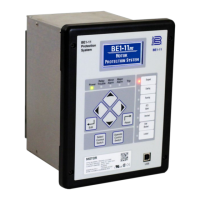29-2 9424200996
Setting Groups BE1-11m
Discrete Inputs
When the setting group selection function block is enabled for Discrete Inputs, there is a direct correlation
between each discrete logic input and the setting group that will be selected. That is, asserting input D0
selects SG0 and asserting input D1 selects SG1, etc. The active setting group latches-in after the input is
read. It is not necessary that the input be maintained. If one or more inputs are asserted at the same time,
the numerically higher setting group will be activated. A pulse must be present for approximately one
second for the setting group change to occur. After a setting group change occurs, no setting group
change can occur within two times the SGC alarm on time. Any pulses to the inputs will be ignored during
that period.
Figure 29-1 shows an example of how the inputs are read when the setting group selection function mode
is enabled for Discrete Inputs. Note that a pulse on the D3 input while D0 is also active does not cause a
setting group change to SG3 because the AUTOMATIC input is active.
Figure 29-1. Input Control Discrete Inputs
When the setting group selection function block is enabled for Binary Inputs, the inputs on D0 and D1 are
read as binary encoded (Table 29-1). Inputs D2 and D3 are ignored. A new coded input must be stable
for approximately one second for the setting group change to occur. After a setting group change occurs,
no setting group change can occur within two times the SGC alarm on time.
Table 29-1. Setting Group Binary Codes
Setting Group
Binary Inputs
When the setting group selection function mode is enabled for Binary Inputs, the active setting group is
controlled by a binary signal applied to discrete inputs D0 and D1. This requires separate logic equations
for only D0 and D1 if all setting groups are to be used. Figure 29-2 shows how the active setting group
follows the binary sum of the D0 and D1 inputs except when blocked by the AUTOMATIC input. Note that
a pulse on the D1 input while D0 is also active does not cause a setting change to SG3 because the
AUTOMATIC input is active.
D3
D2
D1
D0
AUTO
SG3
SG2
SG1
SG0
SGC
P0035-28
05-03-06

